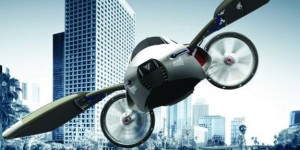If aviation is to break out of its niche and become a ubiquitous mode of transport, then autonomous technology in the air and on the ground is necessary. Whether it’s easy-to-fly personal airplanes, air taxis or single-pilot commuter transports, aviation needs to go beyond automation in order to ensure wider public use of aircraft. Aviation enthusiasts look ahead to the day that air transport is “democratized”, where a mix of personal, air-taxi and other “thin-haul” air vehicles provide “on-demand” mobility for communities over distances of 50-500 miles. However, he acknowledges that there are technological, regulatory and societal challenges to this vision, such as airspace control, usability, safety, noise and enabling robust daily operations in all weathers.
One example is the Hopper electric vertical-takeoff-and-landing (VTOL) regional public transport concept that Stanford University and NASA developed. The baseline vehicle is a 30-passenger tandem-rotor helicopter with battery-electric, fuel-cell or hybrid-electric propulsion. The Hopper is designed for extreme short-haul flights as an alternative to road and rail transport in congested areas. Electric propulsion is heavier, but energy usage is much lower than for turboshaft-powered aircraft. Stanford has conducted simulations of Hopper operations in the San Francisco Bay, where the population density and geography combine to make difficult commutes. The simulations have looked at network operations carrying up to 30,000 passengers every day, which would mean hundreds of Hopper vehicles making thousands of flights between dozens of vertiports connected to road and rail links. With three major airports in the area, this would inevitably raise airspace management issues.
Simulations reveal that dynamic flightpath routing based on the time of day could help reduce potential conflicts with the background air traffic and limit controller workload by avoiding heavily-used airspace. However, enabling a Hopper-style public transport network would require a high level of automation, both on the ground and in the air. The vehicle would be single-pilot, with later potential for fully autonomous operation. Vertiport operation, including charging/changing batteries, would be automated. Flying and VTOL are energy-intensive transportation modes for relatively short distances, yet still represent a potential way to bypass the congestion that comes with urban surface-transportation. Near-term battery technology could make such short-range vehicles feasible within 10 years if airspace and infrastructure challenges can be overcome.
The wealthier of the Bay Area’s tech industry commuters are the main target for Joby Aviation’s S2 electric VTOL two-seater. The design, set to be available within a few years, has 12 electrically driven propellers on the wing and tail that tilt for VTOL and fold in cruise to provide efficiency, redundancy and reduced noise. Point-to-point, it’s five times faster than a car and twice as fast as a Robinson R22 two-seat helicopter, and uses five times less energy than a car and 10 times less than a helicopter. On-demand aviation could also be effective in Los Angeles, where around 233,000 commuters travel 200 miles or more every day to and from work. The best place to start, however, would be to apply autonomy and electric propulsion to general aviation to improve safety, reduce noise and overcome shortcomings in efficiency, emissions, ride quality, robustness and operating costs.
